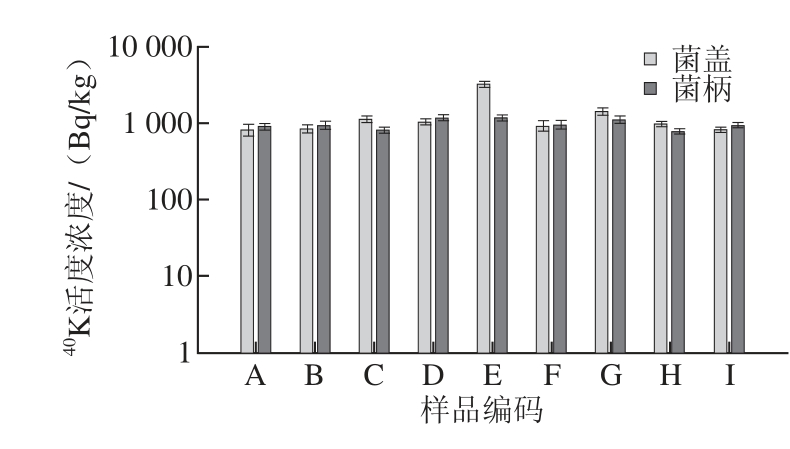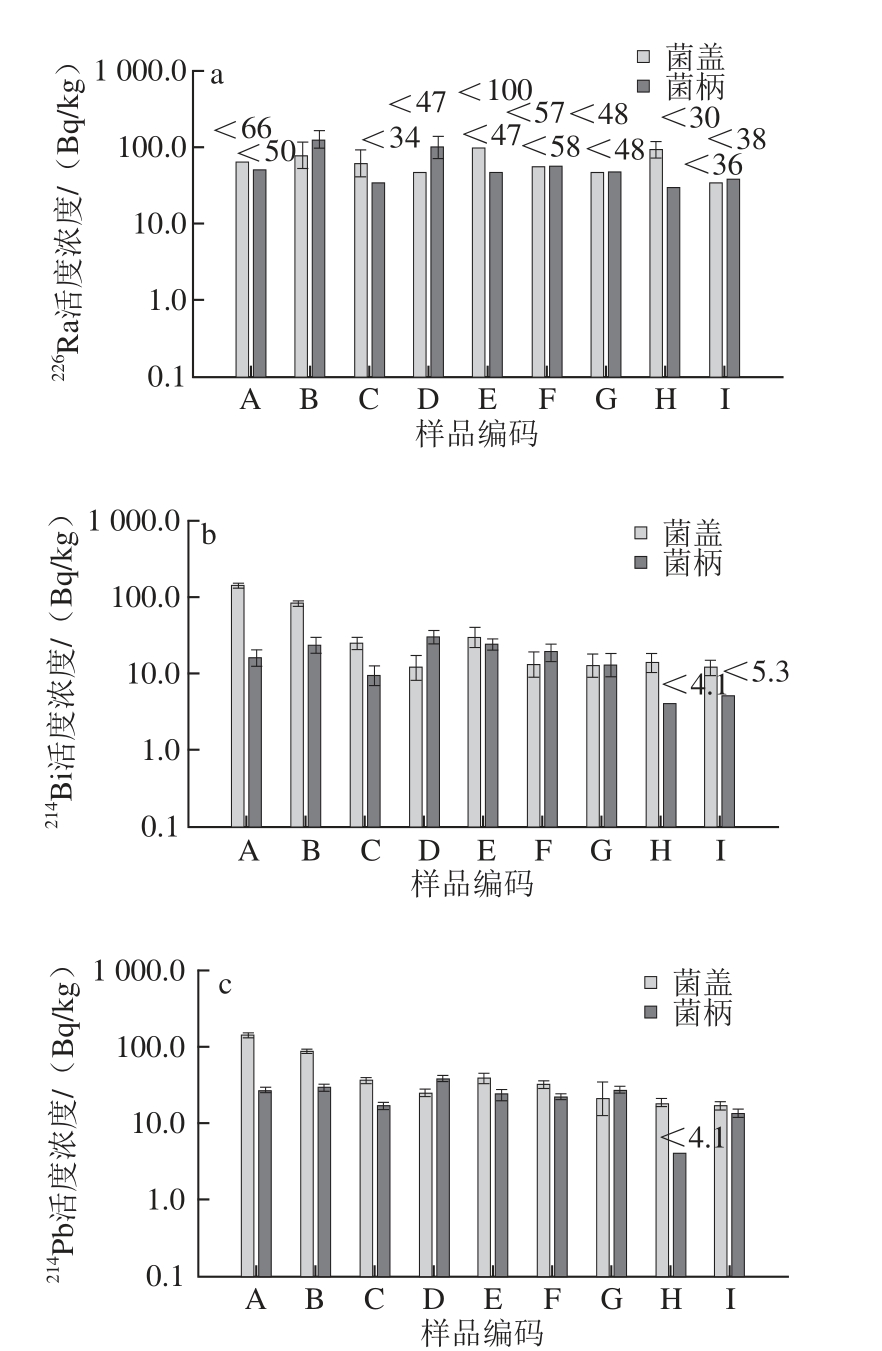
图1 巨大口蘑中
137137Cs活度浓度s
Fig.1
137Cs concentration of fruiting bodies of Macrocybe gigantea
A. 2011年采集的栽培样品;B~E. 2012年采集的野生样品;F~I. 2013年采集的野生样品。图2同。
张 霁 1,Anna ŚLIWIŃSKA 2,Tamara ZALEWSKA 2,Jerzy FALANDYSZ 3,王元忠 1,*
(1.云南省农业科学院药用植物研究所,云南 昆明 650200;2.气象与水管理研究所,波兰 格丁尼亚 81-342;3.格但斯克大学,波兰 格但斯克 80-308)
摘 要:采用高纯锗伽马能谱仪测量云南栽培与野生巨大口蘑中人工放射性核素 137Cs和天然放射性核素 40K、 226Ra、 214Bi、 214Pb的活度浓度。结果显示, 137Cs、 40K、 226Ra、 214Bi、 214Pb活度浓度最高值以干质量计,在2011年样品菌盖中分别为小于6.1、821、小于66、140、145 Bq/kg,在菌柄中分别为6.7、926、小于50、16、27 Bq/kg;在2012年样品菌盖中分别为13、3 323、79、82、85 Bq/kg,在菌柄中分别为6.6、1 194、127、31、39 Bq/kg;在2013年样品菌盖中分别为11、1 417、92、14、32 Bq/kg,在菌柄中分别为7.9、1 139、小于58、19、27 Bq/kg。样品中 137Cs活度浓度远低于国家限量标准及欧洲与日本等受放射性污染地区真菌的活度浓度, 40K、 226Ra、 214Bi、 214Pb活度浓度处于正常水平。表明产于云南的巨大口蘑未受到 137Cs放射性污染,食用无核辐射安全风险。
关键词:食用菌;高纯锗伽马能谱仪;放射性活度; 137Cs
食用菌富含蛋白质、多糖、维生素以及多种营养元素,是重要的食物来源之一 [1]。由于大型真菌具有富集元素的特性,因此除人体必需的营养元素外,研究食用菌中放射性核素活度水平及其对人体健康的影响具有重要意义 [2-5]。早期研究主要调查核武器试验放射尘对食用菌放射性核素活度的影响 [6]。至1986年4月26日,前苏联切尔诺贝利核泄露事故后,欧洲各国开展了大量有关野生菌中放射性核素的研究 [7]。2011年3月11日,受里氏9.0级地震影响,日本福岛核电站发生泄漏事故,核辐射问题再次引起世界关注。根据计算,2 次核事故分别泄漏了总量约为5 300×10 15Bq和340×10 15~800×10 15Bq的放射性物质 [8]。
自20世纪40年代开始,核武器实验与核反应堆建设等因素导致人工放射性核素对环境造成污染。其中 137Cs因其较长的半衰期(30.02 a) [9],可对人体健康产生持续影响,是食用菌研究中报道最多的人工放射性核素。与植物相比,真菌从土壤中吸收富集 137Cs的能力高达百倍以上 [10],在森林生态系统放射性核素的转运过程中扮演着关键角色 [11]。研究发现,食用菌子实体中 137Cs含量的时空变化大于物种间的变化 [12],主要受到菌丝体生长土层(主要为小于5 cm表层土) 137Cs含量的强烈影响 [13]。在白俄罗斯、乌克兰、俄罗斯等受切尔诺贝利事故最污染严重的欧洲国家,食用菌中 137Cs活度浓度最高可达50 700 000 Bq/kg(以干质量计) [14]。
食用菌中天然放射性核素亦有研究,其中 40K报道最多。由于K为必需元素,食用菌中K相对稳定。 40K丰度为0.011 7%,在食用菌中的活度浓度因物种而异,以干质量计算,一般为800~2 000 Bq/kg [14-15]。
中国拥有极为丰富的食用菌资源,可食用真菌超过880 种,产量占世界总量70%以上,但有关食用菌中放射性核素研究几乎为空白 [1,14]。仅有Marzano等 [16]曾报道从中国出口至意大利的牛肝菌 137Cs活度浓度为2.1 Bq/kg(以干质量计)。Wang等 [17]对台湾地区16 种栽培食用菌种放射性核素进行分析,结果显示 137Cs和 40K活度浓度分别为小于7.3 Bq/kg和小于50 Bq/kg(以干质量计)。
巨大口蘑(Macrocybe gigantea (Massee) Pegler & Lodge)为口蘑科真菌 [18],具有重要的食用和药用价值 [19],其子实体中含有丰富的Ca、Fe、K、Mg、Mn、Zn等人体必需元素 [20-21],而有毒元素汞含量远低于联合国粮农组织与世界卫生组织制定的限量标准 [22]。目前有关巨大口蘑放射性核素含量尚未见报道。本研究采用高纯锗伽马能谱仪测量云南栽培与野生巨大口蘑中人工放射性核素 137Cs和天然放射性核素 40K、 226Ra、 214Bi、 214Pb的活度水平,为中国食用菌放射性安全性评价提供基础数据。
1.1 材料
栽培和野生巨大口蘑子实体。其中栽培样品1 份(样品A)于2011年采自云南省普洱市思茅区;野生样品8 份,分别于2012年(样品B~E)和2013年(样品F~I)采自云南省玉溪市元江县。凭证标本存放于云南省农业科学院药用植物研究所标本室,由北京林业大学戴玉成教授鉴定为巨大口蘑。每份样品均包括6 个子实体,分为菌盖与菌柄两部分,分别在85 ℃条件下烘干至恒质量,粉碎,过200 目筛,聚乙烯自封袋封装,约100 g用于放射性核素活度的测定。
1.2 仪器与设备
GC1819-7500SL型高纯锗γ谱仪(8192道分析器)美国Canberra公司。
1.3 方法
各样品中 137Cs、 40K、 226Ra、 214Bi、 214Pb的活度测定实验在波兰气象与水管理研究所开展。仪器相对效率为18%,分辨率为1.9 keV(对 60Co-1.332 meV峰)。γ同位素标准溶液(编号:BW/Z-62/27/07)用于仪器矫正。视样品放射性核素活度强弱不同,1 份样品的测量时间约为24~48 h。数据分析使用GENIE 2000软件。方法的可靠性和准确性经过了国际原子能机构摩纳哥海洋环境实验室的验证 [23]。巨大口蘑菌盖、菌柄中活度浓度均以干质量计。
2.1 人工放射性核素 137Cs活度浓度

图1 巨大口蘑中
137137Cs活度浓度s
Fig.1
137Cs concentration of fruiting bodies of Macrocybe gigantea
A. 2011年采集的栽培样品;B~E. 2012年采集的野生样品;F~I. 2013年采集的野生样品。图2同。
由图1可知,栽培样品中,菌盖 137Cs活度浓度小于6.1 Bq/kg,菌柄 137Cs活度浓度为6.7 Bq/kg;2012年野生样品中, 137Cs活度浓度变化范围在菌盖中为4.2~13 Bq/kg,在菌柄中为小于6.1~6.6 Bq/kg;2013年野生样品中, 137Cs活度浓度变化范围在菌盖中为小于3.0~11 Bq/kg,在菌柄中为小于4.8~7.9 Bq/kg。 137Cs活度浓度在野生与栽培样品之间、菌盖与菌柄之间、不同采集年份样品之间均无显著变化。巨大口蘑中 137Cs活度浓度显著低于欧洲、日本食用菌的活度浓度 [24-31],与Marzano等 [16]测定的中国牛肝菌样品及de Castro等 [32]对巴西几种常见食用菌的测量结果一致。本研究结果表明,巨大口蘑及采样地环境未受到人工放射性核素 137Cs污染。
2.2 天然放射性核素 40K活度浓度

图2 巨大口蘑中
40K活度浓度
Fig.2
40K concentration of fruiting bodies of Macrocybe gigantea
自然界中 40K活度浓度较为稳定。巨大口蘑栽培样品中, 40K活度浓度在菌盖中为821 Bq/kg,在菌柄中为926 Bq/kg;2012年野生样品中, 40K活度浓度变化范围在菌盖中为853~3 323 Bq/kg,在菌柄中为816~1 194 Bq/kg;2013年野生样品中, 40K活度浓度变化范围在菌盖中为821~1 417 Bq/kg,在菌柄中为775~1 139 Bq/kg(图2)。本研究结果与文献[15,25,28-30,33]报道相似。
2.3 天然放射性核素 226Ra、 214Bi、 214Pb活度浓度

图3 巨大口蘑中
226Ra(a)、
214Bi(b)、
214Pb(c)活度浓度
Fig.3 Concentrations of
226Ra,
214Bi and
214Pb in fruiting bodies of Macrocybe gigantean
对食用菌中天然放射性核素 226Ra、 214Bi、 214Pb活度浓度水平的研究相对较少。由图3a所知,大多数样品中 226Ra活度浓度低于检出限。样品H菌盖 226Ra活度浓度最高,为92 Bq/kg,样品B菌柄 226Ra活度浓度最高,为127 Bq/kg。研究 [33]结果与西班牙食用菌中 226Ra活度浓度(1.3~87 Bq/kg)相似,但高于Rakić等 [30]对塞尔维亚食用和药用真菌的报道以及Turhan等 [34]对土耳其野生菌的报道。
巨大口蘑栽培样品菌盖 214Bi活度浓度达140 Bq/kg,显著高于野生样品(12~82 Bq/kg);栽培样品菌柄中 214Bi活度浓度为16 Bq/kg,该值在野生样品菌柄 214Bi活度浓度范围(4.1~31 Bq/kg)内(图3b)。
由图3c可知,栽培样品中, 214Pb活度浓度在菌盖中为145 Bq/kg,在菌柄中为27 Bq/kg;2012年野生样品中, 214Pb活度浓度变化范围在菌盖中为25~85 Bq/kg,在菌柄中为17~39 Bq/kg;2013年野生样品中, 214Pb活度浓度变化范围在菌盖中为17~32 Bq/kg,在菌柄中为小于4.1~27 Bq/kg。本研究中巨大口蘑 214Pb活度浓度高于Kirchner等 [35]报道的法国大型真菌 214Pb活度浓度。
2.4 食用菌放射性核素摄入限量
我国目前尚未制定法规或标准对食用菌放射性核素摄入限量作专门规定。现行GB 14882—1994《食品中放射性物质限制浓度标准》中规定成人年摄入 137Cs限值为77 000 Bq。澳门特别行政区于2014年8月公布的第16/2014号行政法规《食品中放射性核素最高限量》中,规定食品中 137Cs最高限量为1 000 Bq/kg。而新修订的GB 14882—201X《食品中放射性核素限制(草案)》中,将 137Cs限制活度浓度定为300 Bq/kg。本实验巨大口蘑样品中, 137Cs活度浓度最高值为13 Bq/kg,以每人年均食用1 kg鲜质量巨大口蘑(约为0.1 kg干质量)计算, 137Cs摄入量仅为1.3 Bq。 137Cs活度浓度与年摄入量均远低于相应标准及法规,表明通过食用巨大口蘑对人体健康无放射性风险。
对云南栽培与野生巨大口蘑中 137Cs、 40K、 226Ra、 214Bi、 214Pb的活度浓度进行测量,结果表明,人工放射性核素 137Cs活度浓度远低于受放射性污染地区真菌,几种天然放射性核素活度浓度处于正常水平,说明产于云南的巨大口蘑未受到放射性污染。
参考文献:
[1] WANG Xuemei, ZHANG Ji, WU Lihua, et al. A mini-review of chemical composition and nutritional value of edible wild-grown mushroom from China[J]. Food Chemistry, 2014, 151: 279-285.
[2] DIGHTON J, TUGAY T, ZHDANOVA N. Fungi and ionizingradiation from radionuclides[J]. FEMS Microbiology Letters, 2008, 281(2): 109-120.
[3] DUFF M C, RAMSEY M L. Accumulation of radiocesium by mushrooms in the environment: a literature review[J]. Journal of Environmental Radioactivity, 2008, 99(6): 912-932.
[4] GADD G M. Geomycology: biogeochemical transformations of rocks, minerals, metals and radionuclides by fungi, bioweathering and bioremediation[J]. Mycological Research, 2007, 111(1): 3-49.
[5] FALANDYSZ J, BOROVIČKA J. Macro and trace mineral constituents and radionuclides in mushrooms: health benefits and risks[J]. Applied Microbiology and Biotechnology, 2013, 97(2): 477-501.
[6] GRUETER H. Radioactive fission product 137Cs in mushrooms in W. Germany during 1963—1970[J]. Health Physics, 1971, 20(6): 655-657.
[7] KALAČ P. Chemical composition and nutritional value of European species of wild growing mushrooms: a review[J]. Food Chemistry, 2009, 113(1): 9-16.
[8] STEINHAUSER G, BRANDL A, JOHNSON T E. Comparison of the Chernobyl and Fukushima nuclear accidents: a review of the environmental impacts[J]. Science of the Total Environment, 2014, 470: 800-817.
[9] MIETELSKI J W. Encyclopedia of inorganic and bioinorganic chemistry[M]. New York: John Wiley & Sons, 2011.
[10] SUGIYAMA H, SHIBATA H, ISOMURA K, et al. Concentration of radiocesium in mushrooms and substrates in the sub-alpine forest of Mt. Fuji Japan[J]. Journal of the Food Hygienic Society of Japan, 1994, 35(1): 13-22.
[11] STEINER M, LINKOV I, YOSHIDA S. The role of fungi in the transfer and cycling of radionuclides in forest ecosystems[J]. Journal of Environmental Radioactivity, 2002, 58(2): 217-241.
[12] de MEIJER R J, ALDENKAMP F J, JANSEN A E. Resorption of cesium radionuclides by various fungi[J]. Oecologia, 1988, 77(2): 268-272.
[13] YOSHIDA S, MURAMATSU Y. Accumulation of radiocesium in basidiomycetes collected from Japanese forests[J]. Science of the Total Environment, 1994, 157: 197-205.
[14] GUILLEN J, BAEZA A. Radioactivity in mushrooms: a health hazard?[J]. Food Chemistry, 2014, 154: 14-25.
[15] KALAČ P. A review of edible mushroom radioactivity[J]. Food Chemistry, 2001, 75(1): 29-35.
[16] MARZANO F N, BRACCHI P G, PIZZETTI P. Radioactive and conventional pollutants accumulated by edible mushrooms (Boletus sp.) are useful indicators of species origin[J]. Environmental Research, 2001, 85(3): 260-264.
[17] WANG J J, WANG C J, LAI Shuying, et al. Radioactivity concentrations of 137Cs and 40K in basidiomycetes collected in Taiwan[J]. Applied Radiation and Isotopes, 1998, 49(1): 29-34.
[18] 戴玉成, 周丽伟, 杨祝良, 等. 中国食用菌名录[J]. 菌物学报, 2010(1): 1-21.
[19] 张婷, 王元忠, 李杰庆, 等. 大白口蘑研究进展[J]. 中国食用菌, 2013, 32(4): 4-7.
[20] 李涛, 王元忠, 刘鸿高. 巨大口蘑中微量元素的光谱测定[J]. 光谱学与光谱分析, 2008, 28(2): 450-452.
[21] LIU Honggao, ZHANG Ji, LI Tao, et al. Mineral element levels in wild edible mushrooms from Yunnan, China[J]. Biological Trace Element Research, 2012, 147(1/2/3): 341-345.
[22] WIEJAK A, WANG Yuanzhong, ZHANG Ji, et al. Bioconcentration potential and contamination with mercury of pantropical mushroom Macrocybe gigantea[J]. Journal of Environmental Science and Health, Part B, 2014, 49(11): 811-814.
[23] ZALEWSKA T. Distribution of 137Cs in benthic plants along depth profiles in the outer Puck Bay (Baltic Sea)[J]. Journal of Radioanalytical and Nuclear Chemistry, 2012, 293(2): 679-688.
[24] BAN-NAI T, MURAMATSU Y, YOSHIDA S. Concentrations of 137Cs and 40K in edible mushrooms collected in Japan and radiation dose due to their consumption[J]. Health Physics, 1997, 72(3): 384-389.
[25] KARADENIZ Ö, YAPRAK G. 137Cs, 40K, alkali-alkaline earth element and heavy metal concentrations in wild mushrooms from Turkey[J]. Journal of Radioanalytical and Nuclear Chemistry, 2010, 285(3): 611-619.
[26] KUWAHARA C, FUKUMOTO A, OHSONE A, et al. Accumulation of radiocesium in wild mushrooms collected from a Japanese forest and cesium uptake by microorganisms isolated from the mushroom-growing soils[J]. Science of the Total Environment, 2005, 345(1): 165-173.
[27] MIETELSKI J W, JASIŃSKA M, KUBICA B, et al. Radioactive contami nation of Polish mushrooms[J]. Science of the Total Environment, 1994, 157: 217-226.
[28] MIETELSKI J W, DUBCHAK S, BŁAŻEJ S, et al. 137Cs and 40K in fruiting bodies of different fungal species collected in a single forest in southern Poland[J]. Journal of Environmental Radioactivity, 2010, 101(9): 706-711.
[29] MURAMATSU Y, YOSHIDA S, SUMIYA M. Concentrations of radiocesium and potassium in basidiomycetes collected in Japan[J]. Science of the Total Environment, 1991, 105: 29-39.
[30] RAKIĆ M, KARAMAN M, FORKAPIĆ S, et al. Radionuclides in some edible and medicinal macrofungal species from Tara Mountain, Serbia[J]. Environmental Science and Pollution Research, 2014, 21(19): 11283-11292.
[31] ŠKRKAL J, RULÍK P, FANTÍNOVÁ K, et al. Long-term 137Cs activity monitoring of mushrooms in forest ecosystems of the Czech Republic[J]. Radiation Protection Dosimetry, 2013, 157(4): 579-584.
[32] de CASTRO L P, MAIHARA V A, SILVA P S C, et al. Artifi cial and natural radioactivity in edible mushrooms from Sao Paulo, Brazil[J]. Journal of Environmental Radioactivity, 2012, 113: 150-154.
[33] BAEZA A, HERNÁNDEZ S, GUILLÉN F J, et al. Radiocaesium and natural gamma emitters in mushrooms collected in Spain[J]. Science of the Total Environment, 2004, 318(1): 59-71.
[34] TURHAN Ş, KÖSE A, VARINLIOĞLU A. Radioactivity levels in some wild edible mushroom species in Turkey[J]. Isotopes in Environmental and Health Studies, 2007, 43(3): 249-256.
[35] KIRCHNER G, DAILLANT O. Accumulation of 210Pb, 226Ra and radioactive cesium by fungi[J]. Science of the Total Environment, 1998, 222(1): 63-70.
Determination of Radionuclides in Cultivated and Wild Macrocybe gigantea Mushrooms in Yunnan
ZHANG Ji 1, Anna ŚLIWIŃSKA 2, Tamara ZALEWSKA 2, Jerzy FALANDYSZ 3, WANG Yuanzhong 1,* (1. Institute of Medicinal Plants, Yunnan Academy of Agricultural Sciences, Kunming 650200, China; 2. Institute of Meteorology and Water Management, Gdynia 81-342, Poland; 3. University of Gdańsk, Gdańsk 80-308, Poland)
Abstract:In this study, a high-purity germanium γ spectrometer was employed to determine the activities of artificial radionuclide 137Cs and natural radionuclides 40K, 226Ra, 214Bi and 214Pb in fruiting bodies of cultivated and wild Macrocybe gigantea collected in Yunnan, China. The results showed that for the samples collected in 2011, the maximum concentrations of 137Cs, 40K, 226Ra, 214Bi and 214Pb were < 6.1, 821, < 66, 140 and 145 Bq/kg dry weight (dw) in caps, and 6.7, 926, < 50, 16 and 27 Bq/kg in stipes, respectively. For the samples collected in 2012, the values of 137Cs, 40K, 226Ra, 214Bi and 214Pb were 13, 3 323, 79, 82 and 85 Bq/kg in caps, and 6.6, 1 194, 127, 31 and 39 Bq/kg in stipes, respectively. For the samples collected in 2013, the values of 137Cs, 40K, 226Ra, 214Bi and 214Pb were 11, 1 417, 92, 14 and 32 Bq/kg in caps, and 7.9, 1 139, < 58, 19 and 27 Bq/kg dw in stipes, respectively. The concentrations of 137Cs in M. gigantea were much lower than the maximal allowable concentrations of radionuclides in foods as well as the concentrations in fungi collected from contaminated areas in some European countries and Japan. The concentrations of natural radionuclides in M. gigantea were at the normal levels. It is concluded that M. gigantea collected from Yunnan is not contaminated by radiocesium and therefore could be consumed safely without any risk of radiation exposure.
Key words:edible mushroom; high-purity germanium γ spectrometer; radioactivity; 137Cs
中图分类号:R144.1
文献标志码:A
文章编号:1002-6630(2015)20-0198-04
doi:10.7506/spkx1002-6630-201520038
收稿日期:2015-01-20
基金项目:国家自然科学基金地区科学基金项目(31460538;31260496;31160409);国务院农村综合改革专项(2014NG007-18)
作者简介:张霁(1982—),男,助理研究员,硕士,研究方向为药用植物与真菌生态学。E-mail:zjyaas@hotmail.com
*通信作者:王元忠(1981—),男,助理研究员,硕士,研究方向为药用植物与真菌资源。E-mail:boletus@126.com